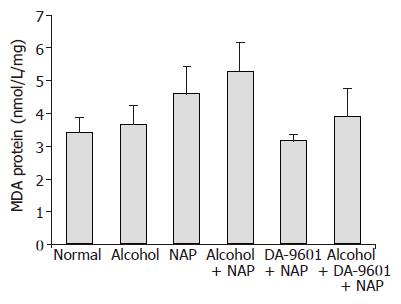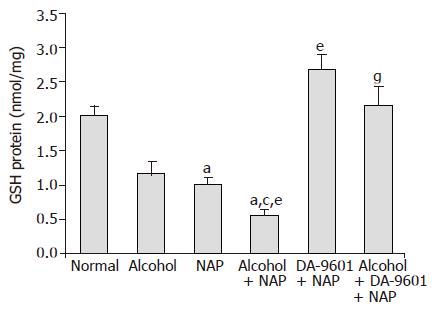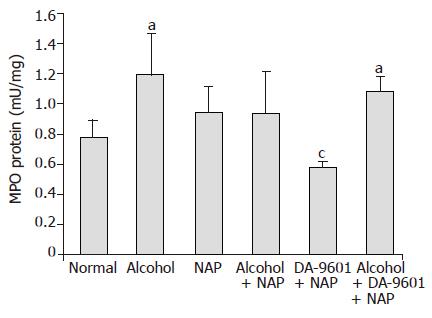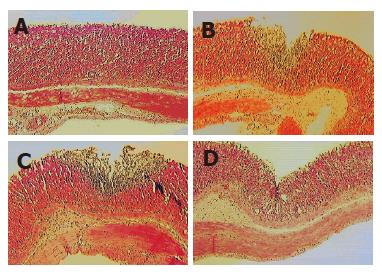Copyright
©2005 Baishideng Publishing Group Inc.
World J Gastroenterol. Dec 21, 2005; 11(47): 7450-7456
Published online Dec 21, 2005. doi: 10.3748/wjg.v11.i47.7450
Published online Dec 21, 2005. doi: 10.3748/wjg.v11.i47.7450
Figure 1 The effect of DA-9601 on the area of gastric lesion induced by alcohol and NAP.
Data are expressed as mean±SD. aP<0.05 vs normal control, cP<0.05 vs alcohol group, eP<0.05 vs NAP, gP<0.05 vs alcohol + NAP.
Figure 2 The effect of DA-9601 on MDA levels in gastric mucosal fluid.
There were no statistical significances among all groups.
Figure 3 The effect of DA-9601 on PGE2 levels in gastric mucosal fluid.
Data are expressed as mean±SD. aP<0.05 vs normal control, cP<0.05 vs alcohol group, eP<0.05 vs NAP, gP<0.05 vs alcohol + NAP.
Figure 4 The effect of DA-9601 on GSH levels in gastric mucosal fluid.
Data are expressed as mean±SD. aP<0.05 vs normal control, cP<0.05 vs alcohol group, eP<0.05 vs NAP, gP<0.05 vs alcohol + NAP.
Figure 5 The effect of DA-9601 on MPO levels in gastric mucosal fluid.
Data are expressed as mean±SD. aP<0.05 vs normal control, cP<0.05 vs NAP group.
Figure 6 Histopathological changes induced either by alcohol, NAP and alcohol + NAP administration and its inhibition by DA-9601.
A: Minimal inflammatory change in gastric mucosa in group II (alcohol); B: Focal epithelial erosion and inflammatory cell infiltration in gastric mucosa and submucosa of group III (NAP); C: Multifocal and diffuse epithelial erosion and severe inflammatory change in gastric mucosa and submucosa of Group IV (alcohol + NAP); D: DA-9601 treatment ameliorates the pathological changes of gastric mucosa and submucosa induced by NAP in alcohol pre-treated group VI (alcohol + DA-9601+NAP).
- Citation: Oh TY, Ahn GJ, Choi SM, Ahn BO, Kim WB. Increased susceptibility of ethanol-treated gastric mucosa to naproxen and its inhibition by DA-9601, an Artemisia asiatica extract. World J Gastroenterol 2005; 11(47): 7450-7456
- URL: https://www.wjgnet.com/1007-9327/full/v11/i47/7450.htm
- DOI: https://dx.doi.org/10.3748/wjg.v11.i47.7450


















